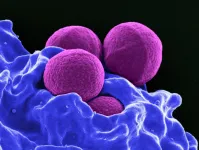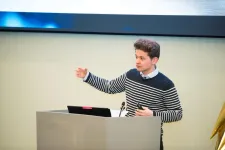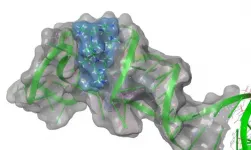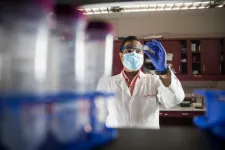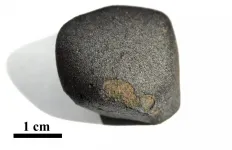Bonobos, chimpanzees, and oxytocin
A key hormone may underlie social differences among great apes
2021-01-21
(Press-News.org) Japan -- Despite being our two closest relatives -- separated by just two million years of evolution from one another and six million from us -- chimpanzees, bonobos, and humans have numerous important differences, such as in lethal aggression demonstrated by chimpanzee males and the high social status of bonobo females.
Now a research study suggests that the hormone oxytocin may have played a central role in this evolutionary divergence.
"Oxytocin is a hormone neuropeptide found in mammals," explains author James Brooks, "but despite its ancient origins, its role can vary even among closely-related species." Among these roles are a wide array of social behaviors, some of which have recently been associated with certain species-typical behaviors in great apes.
Based on these behavioral findings, a team from Kyoto University and Azabu University in Japan examined oxytocin's effect on eye contact, a key social behavior that is known to both differ widely between bonobos and chimpanzees and is tightly tied to the oxytocin system in humans, monkeys, and dogs.
The researchers predicted that if oxytocin is key to the divergence of social traits, it would act differently in the two species and promote species-specific behaviors.
Using a non-invasive technique similar to that employed in tests with humans, oxytocin was nebulized -- made into an aerosol -- into a box where the apes had access to juice should they choose to participate. While drinking the juice, the apes passively inhaled the nebulized mist and were then shown still and video images prepared for each species, while their gaze was recorded with an eye-tracking device.
The team found that for bonobos -- as with humans -- oxytocin shifted attention more to the eyes in the images, while chimpanzees instead shifted their gaze more to mouths. Significantly, these changes enhanced known species differences.
"Due to the importance of eye contact in many social behaviors, such discrepancies could lead to broader behavioral differences through feedback loops, with greater eye contact leading to species-typical behavior leading to further oxytocin release," says co-author Fumihiro Kano.
"These are the first results to demonstrate an effect of administered oxytocin on great ape behavior, pointing to the significant role this hormone plays in the critical differences among the species."
INFORMATION:
The paper "Divergent effects of oxytocin on eye contact in bonobos and chimpanzees" appeared 21 December 2020 in the journal Psychoneuroendocrinology, with doi: 10.1016/j.psyneuen.2020.105119
Author contacts: James Brooks (jamesgerardbrooks@gmail.com, +81 80 8495 3884) and Fumihiro Kano (fkanou@gmail.com, +81 80 6477 1127)
About Kyoto University
Kyoto University is one of Japan and Asia's premier research institutions, founded in 1897 and responsible for producing numerous Nobel laureates and winners of other prestigious international prizes. A broad curriculum across the arts and sciences at both undergraduate and graduate levels is complemented by numerous research centers, as well as facilities and offices around Japan and the world. For more information please see: http://www.kyoto-u.ac.jp/en
[Attachments] See images for this press release:
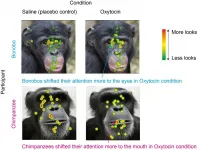
ELSE PRESS RELEASES FROM THIS DATE:
2021-01-21
Staphylococcus aureus (S. aureus) ranks among the globally most important causes of infections in humans and is considered a dreaded hospital pathogen. Active and passive immunisation against multi-resistant strains is seen as a potentially valuable alternative to antibiotic therapy. However, all vaccine candidates so far have been clinically unsuccessful. With an epitope-based immunisation, scientists at Cologne University Hospital and the German Center for Infection Research (DZIF) have now described a new vaccination strategy against S. aureus in the Nature Partner Journal NPJ VACCINES.
S. aureus causes life-threatening conditions such as deep wound infections, sepsis, endocarditis, ...
2021-01-21
PITTSBURGH--A smile that lifts the cheeks and crinkles the eyes is thought by many to be truly genuine. But new research at Carnegie Mellon University casts doubt on whether this joyful facial expression necessarily tells others how a person really feels inside.
In fact, these "smiling eye" smiles, called Duchenne smiles, seem to be related to smile intensity, rather than acting as an indicator of whether a person is happy or not, said Jeffrey Girard, a former post-doctoral researcher at CMU's Language Technologies Institute.
"I do think it's possible that we might ...
2021-01-21
An international research team has developed a fast and affordable quantum random number generator. The device created by scientists from NUST MISIS, Russian Quantum Center, University of Oxford, Goldsmiths, University of London and Freie Universität Berlin produces randomness at a rate of 8.05 gigabits per second, which makes it the fastest random number generator of its kind. The study published in Physical Review X is a promising starting point for the development of commercial random number generators for cryptography and complex systems modeling.
INFORMATION: ...
2021-01-21
ATHENS, Ohio (Jan. 20, 2021) - While the world awaits broad distribution of COVID-19 vaccines, researchers at Ohio University just published highly significant and timely results in the search for another way to stop the virus -- by disrupting its RNA and its ability to reproduce.
Dr. Jennifer Hines, a professor in the Department of Chemistry and Biochemistry, along with graduate and undergraduate students in her lab, published the first structural biology analysis of a section of the COVID-19 viral RNA called the stem-loop II motif. This is a non-coding section of the RNA, which means that it is not translated into a protein, but it is likely key to the ...
2021-01-21
LEXINGTON, Ky. (January 20, 2021) - More than 5.7 million Americans live with Alzheimer's disease and that number is projected to triple by 2050. Despite the growing number there is not a cure. Florin Despa a professor with the University of Kentucky's department of pharmacology and nutritional sciences says, "The mechanisms underlying neurodegenerative diseases are largely unknown and effective therapies are lacking." That is why numerous studies and trials are ongoing around the world including at the University of Kentucky. One of those studies by University of Kentucky researchers was recently published in Alzheimer's & Dementia: Translational Research & Clinical Interventions. It is the ...
2021-01-21
Older adults are managing the stress of the coronavirus pandemic better than younger adults, reporting less depression and anxiety despite also experiencing greater general concern about COVID-19, according to a study recently published by researchers at the UConn School of Nursing.
Their somewhat paradoxical findings, published last month in the journal Aging and Mental Health, suggest that although greater psychological distress has been reported during the pandemic, older age may offer a buffer against negative feelings brought on by the virus's impact.
"When you think about older adulthood, oftentimes, there are downsides. For example, with regard to physical well-being, we don't recover as well from injury or ...
2021-01-21
Not long after the sun goes down, pairs of burying beetles, or Nicrophorus orbicollis, begin looking for corpses.
For these beetles, this is not some macabre activity; it's house-hunting, and they are in search of the perfect corpse to start a family in. They can sense a good find from miles away, because carrion serves as a food source for countless members of nature's clean-up crew. But because these beetles want to live in these corpses, they don't want to share their discovery. As a result, burying beetles have clever ways of claiming their decaying prize all for themselves. In new research published in The American Naturalist, researchers from UConn and The University of Bayreuth have found these beetles recruit microbes to help throw rivals off the scent.
Immediately following ...
2021-01-21
The NFL playoffs are underway, and fans are finding ways to simulate tailgating during the COVID-19 pandemic. Football watch parties are synonymous with eating fatty foods and drinking alcohol. Have you ever wondered what all of that eating and drinking does to your body?
Researchers from the University of Missouri School of Medicine simulated a tailgating situation with a small group of overweight but healthy men and examined the impact of the eating and drinking on their livers using blood tests and a liver scan. They discovered remarkably differing responses in the subjects.
"Surprisingly, we found that in overweight men, after an afternoon of eating and drinking, how their bodies reacted to food and drink was not uniform," said Elizabeth Parks, PhD, professor of nutrition and ...
2021-01-21
University of Arizona researchers read between the lines of tree rings to reconstruct exactly what happened in Alaska the year that the Laki Volcano erupted half a world away in Iceland. What they learned can help fine-tune future climate predictions.
In June 1783, Laki spewed more sulfur into the atmosphere than any other Northern Hemisphere eruption in the last 1,000 years. The Inuit in North America tell stories about the year that summer never arrived. Benjamin Franklin, who was in France at the time, noted the "fog" that descended over much of Europe in the aftermath, and correctly reasoned that it led to an unusually cold winter on the continent.
Previous analyses of annual tree rings have shown that the entire 1783 growing season for the spruce ...
2021-01-21
A meteorite that fell in northern Germany in 2019 contains carbonates which are among the oldest in the solar system; it also evidences the earliest presence of liquid water on a minor planet. The high-resolution Ion Probe - a research instrument at the Institute of Earth Sciences at Heidelberg University - provided the measurements. The investigation by the Cosmochemistry Research Group led by Prof. Dr Mario Trieloff was part of a consortium study coordinated by the University of Münster with participating scientists from Europe, Australia and the USA.
Carbonates are ubiquitous rocks on Earth. They can be found in the mountain ranges of the Dolomites, the chalk cliffs on the island of Rügen, and in the coral reefs of the ...
LAST 30 PRESS RELEASES:
[Press-News.org] Bonobos, chimpanzees, and oxytocin
A key hormone may underlie social differences among great apes

